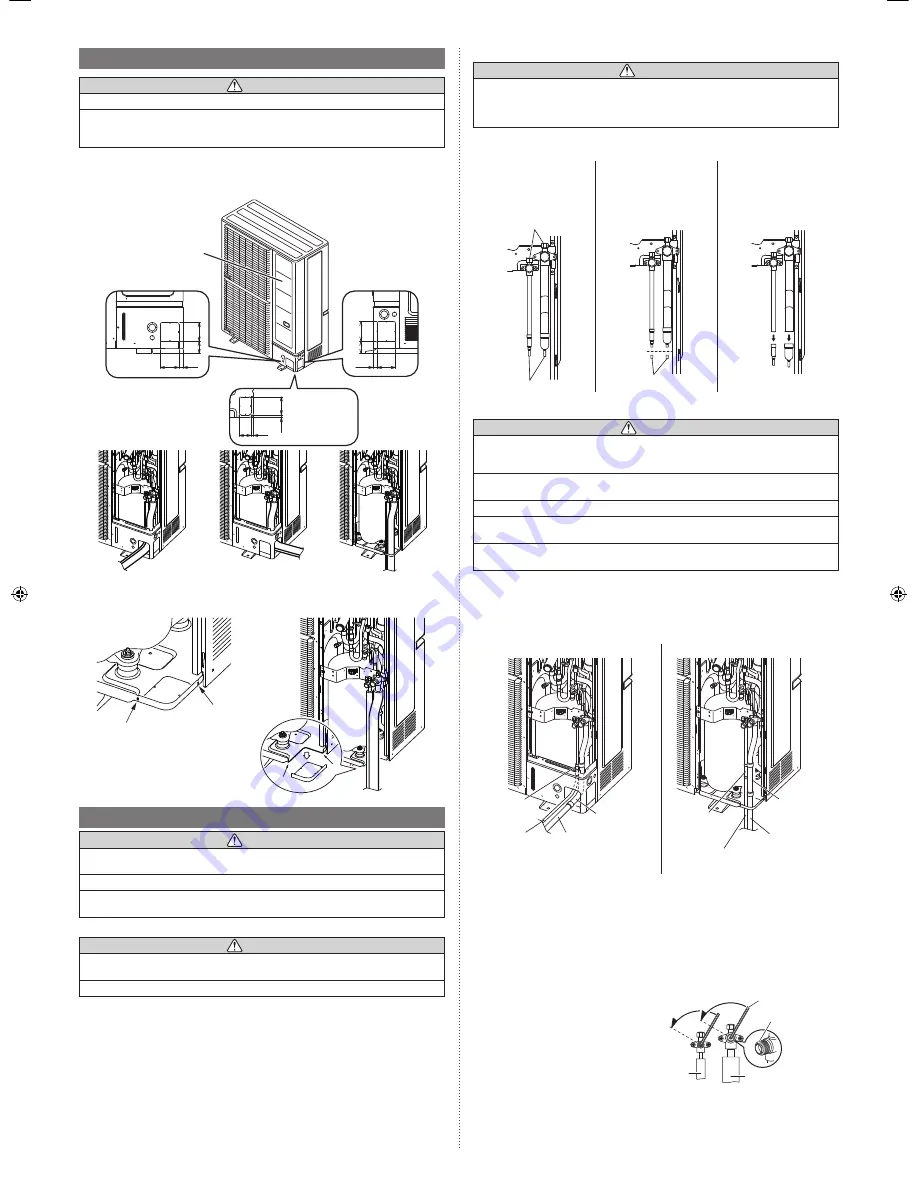
En-7
5.4.2 Removing the pinch pipe
WARNING
Remove the pinch pipe only when the internal gas is completely drained as shown on
the below instructions.
If gas still remains inside, the piping may crack if you melt the brazing filler metal of the
junction area with a burner.
Before connecting the piping, remove the pinch pipe in accordance with the following
instructions:
1) Verify that the liquid
side and gas side 3-way
valves are closed.
2) Cut the end of the liquid
side and gas side pinch
pipe and vent the gas
inside the pinch pipe.
3) After all the gas is vented,
melt the brazing filler
metal on connecting part
using a torch and remove
the pinch pipe.
3-way valves
Pinch pipes
End of pinch pipes
5.4.3 Pipe connection
CAUTION
Seal the pipe route hole with putty (locally purchased) such that there are no gaps.
Small insects or animals that are trapped in the outdoor unit may cause a short circuit in
the electrical component box.
To prevent pipe damage; do not make sharp bends.
Bend the pipe at a radius of 70 mm or greater.
Do not bent pipe many times at same part to prevent break.
After completing all the pipe connection by brazing, perform the indoor unit pipe connec-
tion with a flare joint.
When removing the pinch pipe or brazing the joint pipe, carry out the work while cooling
down the 3-way valve sufficiently.
• Braze the joint pipe onto the 3-way valves at the liquid and gas side. Install the joint pipe
appropriately so that it can be connected easily with the main pipe.
• Braze the joint pipe at the liquid and gas side with the main pipe.
* Be sure to supply nitrogen when brazing.
Connection example
Front connection
Bottom connection
Liquid pipe
(locally
purchased)
Gas pipe
(locally
purchased)
Joint pipe A
(accessory) *1
Joint pipe C
(accessory) *2
Liquid pipe
(locally purchased)
Gas pipe
(locally
purchased)
Joint pipe B
(accessory) *1
Joint pipe C
(accessory) *2
*1: 090/108 model only, *2: 090 model only
5.4.4 Handling precautions for the valves
• Mounted part of Blank cap is sealed for protection.
• Fasten blank cap tightly after opening valves.
Operating the valves
• Use a hexagon wrench (size 3/16 in (4 mm)).
Opening:
(1) Insert the hexagon wrench into the
valve shaft, and turn it counterclock-
wise.
(2) Stop turning when the valve shaft can
no longer be turned. (Open position)
Closing:
(1) Insert the hexagon wrench into the
valve shaft, and turn it clockwise.
(2) Stop turning when the valve shaft can
no longer be turned. (Closed position)
Opening
direction
Hexagon wrench
Seal
(blank
cap
installation
portion)
Liquid
pipe
Gas pipe
Opening
direction
5.3. Opening the knockout hole
CAUTION
Be careful not to deform or scratch the panel while opening the knockout holes.
To protect the piping insulation after opening a knockout hole, remove any burrs from
the edge of the hole. It is recommended to apply rust prevention paint to the edge of the
hole.
• Pipes can be connected from 3 directions, front, lateral side and bottom. (Fig. A)
• When connecting at the bottom, remove the service panel and piping cover on the front
of the outdoor unit, and open the knockout hole provided at the bottom corner of the
piping outlet.
92
21
61
100
94
21
61
94
60 12
14
90
Unit: mm
Fig. A
Service panel
Top view of
the base
Front connection
Lateral connection
Bottom connection
• It can be installed as shown on “Fig. B” cutting out the 2 slits as indicated on “Fig. C”.
(When cutting slits, use a steel saw.)
Slit
Slit
Fig. B
Bottom
connection
Fig. C
5.4. Pipe
connection
CAUTION
Do not use mineral oil on a flared part. Prevent mineral oil from getting into the system
as this would reduce the lifetime of the units.
While brazing the pipes, be sure to blow dry nitrogen gas through them.
The maximum lengths of this product are shown in the table. If the units are further
apart than this, correct operation cannot be guaranteed.
5.4.1 Bending pipes
CAUTION
To prevent breaking of the pipe, avoid sharp bends. Bend the pipe with a radius of
curvature of 4 in (100 mm) or more.
If the pipe is bent repeatedly at the same place, it will break.
• If pipes are shaped by hand, be careful not to collapse them.
• Do not bend the pipes at an angle of more than 90°.
• When pipes are repeatedly bent or stretched, the material will harden, making it difficult
to bend or stretch them any more.
• Do not bend or stretch the pipes more than 3 times.
9380545200-03_IM.indb 7
9380545200-03_IM.indb 7
4/6/2017 3:20:34 PM
4/6/2017 3:20:34 PM





































